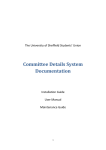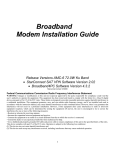Download Radioplayer Ingest HTTP API Client User Guide
Transcript
Radioplayer Ingest HTTP API Client User Guide
Audience
The audience for this document is intended to be technical and addresses the concerns of using
HTTP as a transport for XMLformatted metadata.
Background
The Radioplayer system currently allows stations to send their XML metadata as files using FTP
transport. While this approach provides an easy mechanism for both automated and manual
submission of data it provides poor support for automated checking of the state of processing of
data.
To address this an HTTP API has been developed that will allow stations to submit their
metadata and check the processing state through combination of POST and GET requests.
Introduction
The HTTP API allows authenticated clients to use a POST request to submit their metadata and
supports clients that wish to track the status of their requests using subsequent GET requests.
Each POST request is authenticated and the data checked for compliance to the XML schema.
Failures at this point in processing are reported immediately to the client.
Also, the API employs ratelimiting and in the event that you have too many requests pending
processing the API may respond with an error code indicating that you should retry your request
at a later time.
Once a request has been authenticated, validated and passed through ratelimiting the data is
enqueued for asynchronous processing. The results of this asynchronous processing are
reported through the subsequent GET request mentioned above.
API Usage
In order to use the API you will need an HTTP client that is capable of HTTPS communication,
preemptive authentication, setting request headers, reading response status codes and reading
the response body.
https
The API requires the use of simple HTTPS in all communication.
Preemptive Authentication
The API requires credentials to be submitted with each request.
Metadata Update Request
The API allows clients to submit XML data in the same format that is supported by the
FTPbased ingest mechanism. The ingest server requires that clients use an HTTP POST
method when performing updates.
For each of the following data types a distinct URL is used to perform the update request.
Service Information (SI)
https://ingest.radioplayer.co.uk/ingestor/metadata/v1/si/
Programme Information (PI)
https://ingest.radioplayer.co.uk/ingestor/metadata/v1/pi/
Programme Event (PE)
https://ingest.radioplayer.co.uk/ingestor/metadata/v1/pe/
OffSchedule On Demand (OD)
https://ingest.radioplayer.co.uk/ingestor/metadata/v1/od/
Now Playing (NP)
The API also allows clients to submit a concise form of nowplaying data that does not use an
XML document to communicate the content. Simple request parameters are used instead of an
XML document.
https://ingest.radioplayer.co.uk/ingestor/metadata/v1/np/
The request parameters are as follows
● rpId the station’s Radioplayer Id
● startTime the start time of the now playing data in ISO8601 format, UTC timezone
● duration the duration of the song in seconds
● title song title, max length 128 characters
● artist artist name, max length 128 characters
● description (optional) max length 180 characters
● imageUrl(optional) Url to an image which will be shown in the search result, must be 86
x 48 pixels
A template example of how you could post this data using the commonly found 'curl' command
line utility follows:
curl u yourusername:yourpassword v data
"rpId=YOUR_RPID&startTime=20131001T08:27:00&duration=600&title=SONG
TITLE&artist=ARTIST" X POST
"https://ingest.radioplayer.co.uk/ingestor/metadata/v1/np/"
Read response
After each request the client must read the status code and the response from the ingest server.
The status codes that the server may respond with are as follows
202 Accepted
This indicates that the request has been accepted for asynchronous processing. The response
body will contain the URL that the client may use to determine the status of the request.
503 RetryAfter
This indicates that the request exceeds the rate of allowed update requests and that you must
retry the request. The time at which you should retry the request is expressed in seconds as an
offset from the time you received this response and is provided to your client in a response
header called ‘RetryAfter’.
Request Processing Status
Once your request has been accepted you may make further requests for the processing status.
The URL on which you can find the processing status is provided in the response header called
‘Location’.
Status Tracking
The status of your ‘Accepted’ request can be tracked using a GET request to the URL provided
in the response header ‘Location’. The response to this status tracking request is a JSON string
showing the latest status of processing.
Example:
{
"id":"261702",
"timestamp":"30Mar2012 17:17:04 BST",
"protocol":"Http",
"type":"PI",
"scope":" RpIds:308 startTime:20120120T00:00:00Z, stopTime:20120121T00:00:00Z",
"downstreamStatuses":[
{
"downstream":"solr",
"status":"accepted"
}
]
}
Lifecycle of a request
A request received from client to server will go through the following stages or statuses
● Accepted Request is authenticated and validated successfully and queued for
asynchronous processing by downstream systems.
● Processed Request is successfully processed by downstream systems.
●
●
Failed Request failed during processing, due to an error.
Timedout Request is timedout, as there is no response from downstream after a
certain period of time.
Status of metadata POST requests will only be available for x minutes after the processing is
completed (success/failure). If the request is not getting processed after y minutes, then it is
considered as a timedout request and will be purged after x minutes from then.












